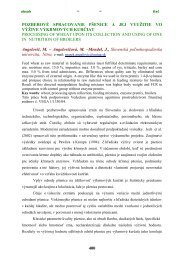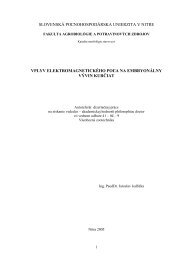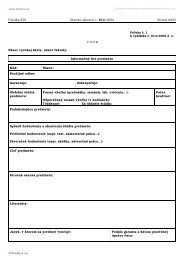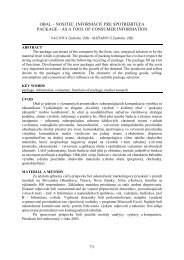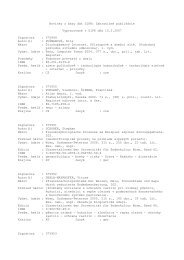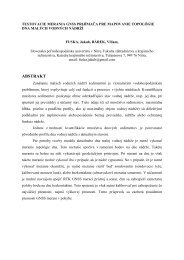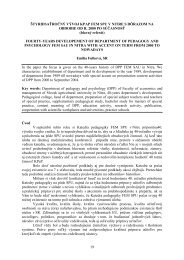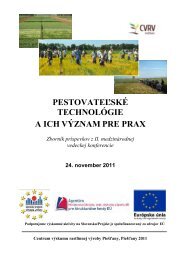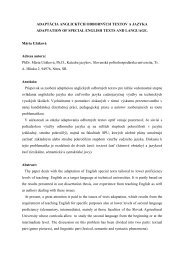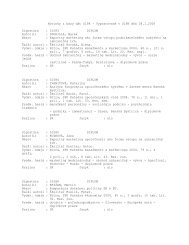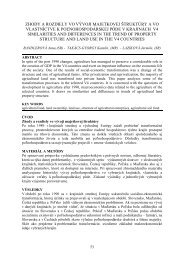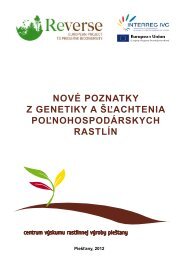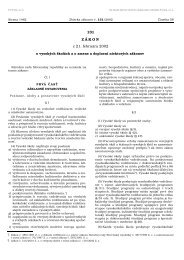<strong>Acta</strong> <strong>fytotechnica</strong> <strong>et</strong> <strong>zootechnica</strong>, <strong>Vol</strong>. 4, <strong>2001</strong>, <strong>Special</strong> <strong>Number</strong> Proceedings of the International Scientific Conference on the Occasion of the 55 th Anniversary of the Slovak Agricultural University in Nitra Actual weed infestation in the spring during the years of observation was very high and varied from 25.5 to 78.8 weeds per m 2 and was from 1.1 to 2.5 times higher in ecological than in integrated system. In integrated system the herbicides Granstar 75 WG and Agritox 50 SL was used, with good to excellent efficacy on weed flora. <strong>Number</strong> of weeds and their weight before the harvest of winter wheat were in integrated system lower by 4.2 – 22.6 times in comparison with ecological system. The dominant weed species in ecological system were perennials: Medicago sativa, Cirsium arvense, Cardaria draba and annual weed species: Tripleurospermum perforatum. Concurrence ability of winter wheat stand and applied mechanical measures lower the number of weeds at later stages of winter wheat development and growth. Table 2: Actual weed infestation of winter wheat stand (average for 1998 – 2000) Year Farmin g system s No. of weeds in spring No.m - 2 % Most frequent weeds in spring No. of weeds before harvest per m 2 % Dry matter weight of weeds g.m -2 % Most frequent weeds in summer 1998 1999 2000 98- 00 A 25.23 100. 0 B 63.23 250. 6 XAB 44.39 - A 71.12 100. 0 B 78.80 110. 8 XAB 74.96 - A 33.19 100. 0 B 46.75 140. 9 XAB 39.97 - XA 43.18 100. 0 XB 62.93 145. 7 TRIPE, CARDR, CAPBP, CIRAR TRIPE, CARDR, CAPBP, CIRAR TRIPE, CARDR, CAPBP, CIRAR CIRAR, TRIPE, MEDSA, CHEAL CIRAR, TRIPE, MEDSA, CHEAL CIRAR, TRIPE, MEDSA, CHEAL MEDSA, TRIPE, CIRAR, CAPBP MEDSA, CIRAR, TRIPE, STEME MEDSA, CIRAR, TRIPE, STEME TRIPE, MEDSA, CIRAR, CARDR MEDSA, CIRAR, TRIPE, CARDR 0.25 100.0 0.29 100.0 1.91 764.0 6.54 2255. 2 1.08 - 3.42 - 1.75 100.0 8.49 100.0 12.8 731.4 84.30 992.9 7.26 - 46.40 - 5.75 100.0 20.40 100.0 28.50 495.7 81.63 400.2 17.13 - 51.02 - 2.58 100.0 9.73 100.0 14.40 558.1 57.49 590.9 CONAR, LATTU, - , - CIRAR, TRIPE, STEME, - CIRAR, TRIPE, CONAR, LATTU CONAR, CIRAR, - , - CONAR, CIRAR, TRIPE, - CONAR, CIRAR, TRIPE, - CONAR, CIRAR, MEDSA, TRIPE CIRAR, MEDSA, TRIPE, SONAR CIRAR, CONAR, MEDSA, TRIPE CONAR, CIRAR LATTU, MEDSA CIRAR, CONAR, MEDSA, TRIPE MEDSA, TRIPE, CIRAR, CONAR, xAB 53.06 - 8.49 - 33.61 - CIRAR, CARDR MEDSA, TRIPE Legend: A – integrated system, B – ecological system, xAB – average AB, TRIPE - Tripleurospermum perforatum, CARDR – Cardaria draba, CAPBP – Capsella bursa-pastoris, CIRAR – Cirsium arvense, CONAR – Convolvulus arvensis, LATTU – Lathyrus tuberosus, STEME – Stellaria media, CHEAL – Chenopodium album, MEDSA – Medicago sativa. References LACKO-BARTOŠOVÁ, M. – MINÁR, M. – TÝR, Š. – BORECKÝ, V. 2000. Zmeny potenciálnej zaburinenosti pôdy v integrovanom a ekologickom systéme hospodárenia na ornej pôde. In: Poľnohospodárstvo, 1, 46, 2000, p. 44-52. ISSN 0551-3677. TÝR, Š. 1997. Vplyv sústav hospodárenia na zaburinenosť porastov pestovaných plodín. DDP. Nitra: SPU, AF, 1997, 186 p. 21
<strong>Acta</strong> <strong>fytotechnica</strong> <strong>et</strong> <strong>zootechnica</strong>, <strong>Vol</strong>. 4, <strong>2001</strong>, <strong>Special</strong> <strong>Number</strong> Proceedings of the International Scientific Conference on the Occasion of the 55 th Anniversary of the Slovak Agricultural University in Nitra TÝR, Š. 1999. Influence of arable farming systems on actual weed infestation of selected crop. In: <strong>Acta</strong> <strong>fytotechnica</strong> <strong>et</strong> <strong>zootechnica</strong>; mimoriadne číslo: Trendy v agropotravinárstve, 2, 1999, p 153. ISSN 1335-258X. TÝR, Š. – LACKO-BARTOŠOVÁ, M. 1998. Weed infestation of spring barley in integrated and ecological arable farming systems. In: 5 th Congress ESA, volume 1, 1998, p. 129. ISBN 80-7137-500-4. TÝR, Š. – POSPIŠIL, R. 1999. Pestovanie hustosiatych obilnín bez používania herbicídov. In: Poľnohospodárstvo, 2, 45, 1999, p. 108-119. ISSN 0551-3677. The authors thank the grant agency VEGA no. 1/6124/99 for supporting of this project. THE INFLUENCE OF DIFFERENT SOIL CULTIVATION INTENSITY ON SOIL HUMIDITY DYNAMICS IN MAIZE STAND Summary Jozef SMATANA, Pavol OTEPKA Department of Agricultural systems, Slovak Agricultural University, Tr. A. Hlinku 2, 949 76 Nitra, Slovak Republic The soil humidity by different cropping systems and different soil cultivation have been evaluated at the Experimental Base Dolná Malanta near Nitra on brown clay – loamy soil during 1995-1997. The influence of cultivation – mouldboard ploughing plus surface cultivation of ploughed field (B1) and combined cultivator only (B3) on soil humidity dynamics has been ascertained. The maize was growing at four course crop rotation after winter wheat as a pre-crop plant. Samples were taken five times during veg<strong>et</strong>ation period to the depth of 0.6 m with six levels at 0.1 m range. No significant differences b<strong>et</strong>ween two soil cultivation in any depth level have been noted. Key words: soil humidity, soil cultivation, minimisation, maize. Introduction Soil cultivation is one of the basic points in crops cultivation. Actual soil humidity is changing quite quickly in shallow layer of soil by soil cultivation. Water in the soil has many very important functions, mainly for soil fertility, because soil water with nutrients tog<strong>et</strong>her are one of the main conditions for cultivating crops. Therefore adjustment of water regime is one of most important aims of soil cultivation. Favourable content of water in the soil has positive impact for soil cultivation (quality of cultivation, lower energy consumption <strong>et</strong>c.). Mechanical effect of soil cultivation regulates the thermodynamic conditions in arable layer of soil and permeability of the soil for water. This depend of granularity, structure of mineral soil composition and sorption complex, as well. Soil permeability is significantly increased by soil fauna, vertical crevices in the dry heavy soil, <strong>et</strong>c. Mechanical loosen of the soil increases soil permeability at all. Soaking of water to the soil is decreased by soil compaction and consolidation. Materials and m<strong>et</strong>hods Experiments were established on Research Station of Slovak Agricultural University in Nitra, Dolná Malanta, on clay-loamy brown soil, which are created on loess parent rock. Research Station is situated in warm climate region, 173 m above sea level, with average annual air’s temperature 9.6°C, average annual precipitation 580 mm. Content of humus in arable layer (0.0-0.35 m) is 2.33 %. Rate of humid acid to fulvid acid is 1.31; exchange acidity (in KCl) is 5.49; volume weight reduced is 1.32 g.cm -3 ; porosity 49 %, maximal capillary water’s capacity 34 %; minimal air’s capacity 15 % and cationic sorption capacity is 165.4 mmol chemical equivalent for 1 kg of soil (Hanes <strong>et</strong> al., 1991). The soil humidity was observed in different farming systems and different basic soil cultivation in maize stand during 1995, 1996 and 1997. Winter wheat was a pre-crop for maize, spring barley and common pea were cultivated after maize. Variations of soil cultivation were: ploughing to the depth of 0.3 m with following of surface arrangement of ploughed field (B1) and loosening of soil with combinatory (B3). Whole block was fertilising by balance m<strong>et</strong>hod for average yield’s level of 8 t.ha -1 . Soil humidity was d<strong>et</strong>ermined five-times during veg<strong>et</strong>ative period of maize to the depth of 0.60 m at six layers, regularly with 0.1 m intervals of depth in three replications. Dates of sampling was d<strong>et</strong>ermined by the most important of agrotechnical operations and growing stages of crop, as well. Evaluation of founded data were done by analysis of variance with helping of appropriate tables. Results and discussion 22
- Page 1 and 2: Acta fytotechnica et zootechnica, V
- Page 3 and 4: Acta fytotechnica et zootechnica, V
- Page 5 and 6: Acta fytotechnica et zootechnica, V
- Page 7 and 8: Acta fytotechnica et zootechnica, V
- Page 9 and 10: Acta fytotechnica et zootechnica, V
- Page 11 and 12: Acta fytotechnica et zootechnica, V
- Page 13: Acta fytotechnica et zootechnica, V
- Page 17 and 18: Acta fytotechnica et zootechnica, V
- Page 19 and 20: Acta fytotechnica et zootechnica, V
- Page 21 and 22: Acta fytotechnica et zootechnica, V
- Page 23 and 24: Acta fytotechnica et zootechnica, V
- Page 25 and 26: Acta fytotechnica et zootechnica, V
- Page 27 and 28: Acta fytotechnica et zootechnica, V
- Page 29 and 30: Acta fytotechnica et zootechnica, V
- Page 31 and 32: Acta fytotechnica et zootechnica, V
- Page 33 and 34: Acta fytotechnica et zootechnica, V
- Page 35 and 36: Acta fytotechnica et zootechnica, V
- Page 37 and 38: Acta fytotechnica et zootechnica, V
- Page 39 and 40: Acta fytotechnica et zootechnica, V
- Page 41 and 42: Acta fytotechnica et zootechnica, V
- Page 43 and 44: Acta fytotechnica et zootechnica, V
- Page 45 and 46: Acta fytotechnica et zootechnica, V
- Page 47 and 48: Acta fytotechnica et zootechnica, V
- Page 49 and 50: Acta fytotechnica et zootechnica, V
- Page 51 and 52: Acta fytotechnica et zootechnica, V
- Page 53 and 54: Acta fytotechnica et zootechnica, V
- Page 55 and 56: Acta fytotechnica et zootechnica, V
- Page 57 and 58: Acta fytotechnica et zootechnica, V
- Page 59 and 60: Acta fytotechnica et zootechnica, V
- Page 61 and 62: Acta fytotechnica et zootechnica, V
- Page 63 and 64: Acta fytotechnica et zootechnica, V
- Page 65 and 66:
Acta fytotechnica et zootechnica, V
- Page 67 and 68:
Acta fytotechnica et zootechnica, V
- Page 69 and 70:
Acta fytotechnica et zootechnica, V
- Page 71 and 72:
Acta fytotechnica et zootechnica, V
- Page 73 and 74:
Table 3: Mathematically and statist
- Page 75 and 76:
Acta fytotechnica et zootechnica, V
- Page 77 and 78:
Acta fytotechnica et zootechnica, V
- Page 79 and 80:
Acta fytotechnica et zootechnica, V
- Page 81 and 82:
Acta fytotechnica et zootechnica, V
- Page 83 and 84:
Acta fytotechnica et zootechnica, V
- Page 85 and 86:
Acta fytotechnica et zootechnica, V
- Page 87 and 88:
Acta fytotechnica et zootechnica, V
- Page 89 and 90:
Acta fytotechnica et zootechnica, V
- Page 91 and 92:
Acta fytotechnica et zootechnica, V
- Page 93 and 94:
Acta fytotechnica et zootechnica, V
- Page 95 and 96:
Acta fytotechnica et zootechnica, V
- Page 97 and 98:
Acta fytotechnica et zootechnica, V
- Page 99 and 100:
Acta fytotechnica et zootechnica, V
- Page 101 and 102:
Acta fytotechnica et zootechnica, V
- Page 103 and 104:
Acta fytotechnica et zootechnica, V
- Page 105 and 106:
Acta fytotechnica et zootechnica, V
- Page 107 and 108:
Acta fytotechnica et zootechnica, V
- Page 109 and 110:
Acta fytotechnica et zootechnica, V
- Page 111 and 112:
Acta fytotechnica et zootechnica, V
- Page 113 and 114:
Acta fytotechnica et zootechnica, V
- Page 115 and 116:
Acta fytotechnica et zootechnica, V
- Page 117 and 118:
Acta fytotechnica et zootechnica, V
- Page 119 and 120:
Acta fytotechnica et zootechnica, V
- Page 121 and 122:
Acta fytotechnica et zootechnica, V
- Page 123 and 124:
Acta fytotechnica et zootechnica, V
- Page 125 and 126:
Acta fytotechnica et zootechnica, V
- Page 127 and 128:
Acta fytotechnica et zootechnica, V
- Page 129 and 130:
Acta fytotechnica et zootechnica, V
- Page 131 and 132:
Acta fytotechnica et zootechnica, V
- Page 133 and 134:
Acta fytotechnica et zootechnica, V



